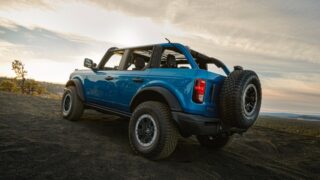DEARBORN, Mich., Feb. 16, 2004 – The 2004 Ford F-150 SuperCab and SuperCrew have each earned the top safety score in the federal government’s frontal impact crash test – five stars for the driver and five stars for the front-seat passenger.
In the National Highway Traffic Safety Administration (NHTSA) test, officially known as the New Car Assessment Program (NCAP), vehicles are rated on the protection provided to properly seat belt restrained occupants in a frontal collision. Five stars indicate the best crash protection. More occupant fatalities and injuries occur in frontal crashes than any other type of crash.
“The five-star ratings confirm our own analysis of the safety performance of this excellent vehicle,” said Jim Vondale, director, Automotive Safety Office. “The F-150 has a strong record for real-world safety.”
The new F-150 also recently received the Insurance Institute for Highway Safety’s (IIHS) highest ranking of “Best Pick” in frontal crash performance. The F-150 was the first, and only, pickup truck to receive a “Best Pick” in the high-speed frontal offset crash category.
2004 F-150
The new F-150 has been designed, engineered and manufactured to be a breakthrough product that resets the competitive benchmark within the full-size pickup truck segment. Key to this effort is safety performance. The 2004 F-150 has been developed with a dedicated focus on safety, making it the safest F-150 ever, as is evidenced from the enhancements below:
- Crash-optimized structure: If a collision is unavoidable, the new F-150 helps to protect its occupants with a structure designed to help absorb and dissipate crash energy and maintain occupant compartment integrity.
- Restraint systems: Advanced restraints provide additional occupant protection, which now includes passenger occupant classification as part of more than a dozen elements that make up the Personal Safety System – a suite of restraint technologies designed to tailor their response to the severity of the crash and other factors.
- Beltminder: A vehicle occupant’s best line of defense in crashes remains the safety belt. Ford Motor Company’s industry-leading technology reminds the driver and front-seat passenger to buckle up by sounding a gentle tone and displaying an icon on the instrument panel.
- Child passenger safety: All new F-150 trucks have three sets of LATCH (Lower Anchors and Tethers for Children) fixtures and top tether anchors across the rear seat of SuperCab and SuperCrew models, and a top tether anchor on the front passenger seat. Regular Cab models have both LATCH lower anchors and a top tether anchor on the front passenger seat.
In addition to its emphasis on safety, the new 2004 F-150 extends its segment leadership through major improvements in several key areas, including:
- Capability – The 2004 F-150 over delivers on the tough truck capability buyers have come to expect by achieving best-in-class trailer towing, best-in-class payload, best-in-class cargo box volume, best-in-class frame strength and class-leading low-end torque.
- Driving Dynamics – The new F-150 does not compromise in providing outstanding ride and handling not typically expected in a pickup truck through advancements such as a twice-as-strong frame, a front suspension featuring class-exclusive cast aluminum lower control arms, the addition of rack-and-pinion steering, larger brakes, and rear shock absorbers mounted outside the frame rails.
- Interior Design – With six inches added to Regular Cab and SuperCab for best-in-class interior volume within these configurations, greater access through a class-exclusive all four-door lineup, and an exclusive overhead rail storage system, the 2004 F-150 – the quietest pickup in the segment – raises the bar on interior design and craftsmanship to lofty heights.
- Customer Choice – With three cab styles, three box lengths, two box styles and five distinct series (XL, STX, XLT, FX4 and Lariat), the F-150 offers the industry’s widest variety of configurations and provides at-a-glance exterior and interior differentiation not seen previously in a pickup truck.
Ford designs all of its vehicles with the objective of reducing the risk and severity of injury in an accident. Ford safety engineers and experts use the most advanced computer technology in the industry to ensure its vehicles meet or exceed stringent crashworthiness standards. Only vehicle designs that effectively absorb impact energy and help provide occupant safety during computer simulation are chosen for further testing and development.
Ford incorporates an array of other very stringent safety testing in the development of its vehicles, including frontal offset, side impact and rear impact.




